 France. Built 1901-1907, service until 1928:
France. Built 1901-1907, service until 1928:Armored Cruiser Léon Gambetta (1903), Jules Ferry (1903), Victor Hugo (1904).
WW1 French Cruisers
Sfax | Tage | Amiral Cecille | D'Iberville class | Dunois class | Foudre | Davout | Suchet | Forbin class | Troude class | Alger class | Friant class | Linois class | Descartes class | D'Assas class | D’Entrecasteaux | Protet class | Guichen | Chateaurenault | Chateaurenault | D'Estrées class | Jurien de la Graviere | Lamotte-Picquet classDupuy de Lome | Amiral Charner class | Pothuau | Jeanne d'Arc | Gueydon class | Dupleix class | Gloire class | Gambetta class | Jules Michelet | Ernest Renan | Edgar Quinet class
The Léon Gambetta class included Léon Gambetta (launched 1901), Jules Ferry (1903), and Victor Hugo (1904), started in 1901-03, completed in 1905-07. They followed the three Gloire class but larger and more powerfully armed. Their 47 mm QF were more efficient, and their four 194-millimeter (7.6 in) guns packed a punch. Gambetta struck a reef in sea trials. Protection under the waterline was mediocre, causing a tragic end to Gambetta in WW1. Léon Gambetta was initially assigned to the Northern Squadron as flagship. Jules Ferry and Victor Hugo went to the Mediterranean Squadron, Jules Ferry as flagship. Gambetta joined them 1910. They escorted convoys and capital ships in wartime and the blockade of the Austro-Hungarian Navy in the Adriatic Sea, until 1917.
On April 27, 1915, the Austrian submarine U5 hit Gambetta with two torpedoes. She capsized and sank in 10 minutes with almost all her crew including Rear-Admiral Senes. Victor Hugo accompanied the battleship Jean Bart to Malta, after the latter took a torpedo hit. Later she evacuated with the cruiser Michelet, Serbian troops from Corfu to Bizerte.
By mid-1917, Jules Ferry became a transport, Victor Hugo was in reserve, joined by the other in mid-1918. Reactivated in 1921 they joined the Atlantic Flying Division and in 1922–1925, alternated in the Far East, placed in reserve in 1928, stricken in 1930.
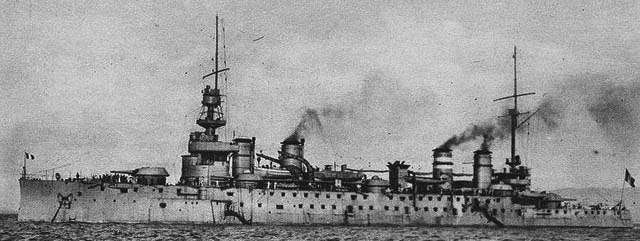
The Fashoda Incident of 1898 and withdrawal from Sudan, the Niger River British domination forced the realization to the 3rd Republic of an unpreparation for any war with Britain neither defending colonies or forcing a blockade. The political uncertainties which led to frequent changes seems to wane as this time successive minister were able to follow a new naval strategy. The first was to consider the Jeune École had enough torpedo boats to provent a close blockade and led the less traditionalist to seek a counter, distant blockade strategy with the Britsh capital ships at home in order to break out en masse. The Marine Nationale needed to neutralized British light forces monitoring her ports and notify the british battlefleet.
Armored cruisers used until there for commerce-raiding role could play this new role, “cleaning up” the sea from these forces, leaving the admiralty in the blind and the opportunity of a sorties en masse. The Naval Law of 1900 required thus no less than five ships. The first three would be the Léon Gambetta class, followed by Ernest Renan and the two Edgar Quinet class, very close but incrementally improved. They were all completed as HMS Dreanought was herself. These were the final French cruisers until the 1920s Duguay Trouin class.
Design of the class

Hull and general design
The Gambettas were designed as enlarged and more powerful versions of the Gloire-class armored cruisers. Léon Gambetta and Jules Ferry measured 148.35 meters (486 ft 9 in) overall, 21.4 meters (70 ft 3 in) in beam and with a draft of 8.18 meters (26 ft 10 in). Victor Hugo was longer at 149.07 meters (489 ft 1 in) however. This was only due to the Yard’s own liberies about the design. Displacement was to be 12,550 metric tons (12,352 long tons) at normal load, and over 15,000 at full load, which was quite respectable as this was aboiut the same of the contemporary battleships of the Republique and Patrie class. The crew comprised 26 officers and 708 enlisted men with facilities to act as flaships and accomodations for 4 more officers and c40 more men.
Their silhouette reproduced in large parts the Gloire design, albeit stretched (146 vs 150m) on the same breadth. This means they had a more favourable hull ratio. Otherwise, they had four funnels far apart in two groups like the Gloire. The rest was thus roughly similar with a tall bridge forward, on which was placed the conning tower, en enclosed bridge built above and an open one on top. Only the foremast was a military one, with a large tube and spotting top, topped by a platform with searchlight. Others were on lower platforms, including one on the aft pole mainmast. They also had a relatively tall structure aft with platforms for light guns. As usual the hull had a very elliptic profile seen from above, with an ‘S’ type ram bow, long forecastle with high freeboard and lower deck aft ending with a pointy stern. Casemated Artillery was limited to a few guns, two forward, two amidships. The rest was all in turrets on the upper deck.
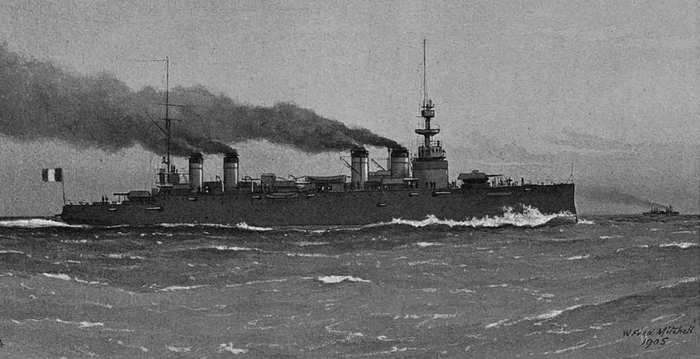
Painting for Brasseys 1905
Powerplant
The Gambetta class like previous ships repeated the classic formula of three shafts, one central for cruising, two outer ones for speed. All three were driven by four-cylinder vertical triple-expansion steam engines, and the outer shafts drove 5.5-meter (18 ft 1 in) 3-bladed propellers, the axis one being smaller at 5 meters (16 ft 5 in) and 4-bladed for lower rotations. Steam came from 20 (Jules Ferry) or 28 water-tube boilers on the two others for a grand total ouptut of 27,500 metric horsepower (20,200 kW).
The boilers diverged between ships: Léon Gambetta had Niclausse boilers, Jules Ferry had 28 Guyot-du Temple boilers (which were larger and more powerful, so just 20 instead), Victor Hugo had with 28 Belleville boilers. Design speed was 22 knots (41 km/h; 25 mph) but on sea trials, they wereable to reach 22.3–23 knots (41.3–42.6 km/h; 25.7–26.5 mph) based on 28,344–29,029 metric horsepower (20,847–21,351 kW). For range they had a amssive amount of coal, some 2,100 long tons (2,100 t) which gave them however “only” 7,500 nautical miles (13,900 km; 8,600 mi) at 10 knots (19 km/h; 12 mph). Electrical power necessary when they were at anchor for all weapons systems and lighting nedded the installation four 1200-ampere dynamos.
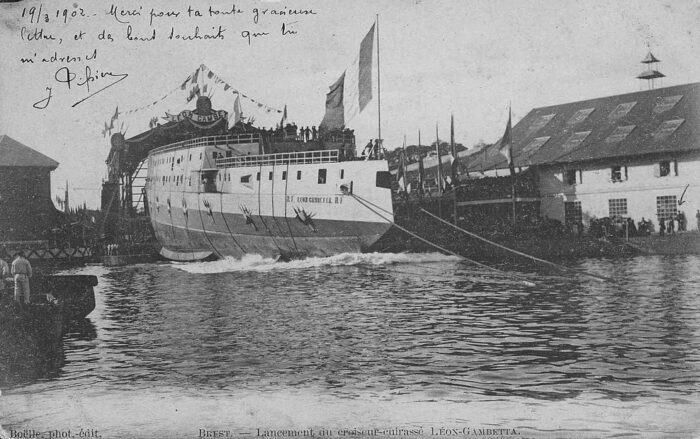
Launch of Leon Gambetta in Brest
Protection
The Léon Gambetta were covered by a total of 3,011 metric tons (2,963 long tons) of armour, more than the Gloire class. Here is the detail.
Waterline armour belt: Harvey armour, 150 mm (5.9 in) amidships, 90 mm (3.5 in) bow, 80 mm (3.1 in) stern.
Belt height: 2.05 meters (6 ft 9 in).
Lower edge: 50–70 millimeters (2.0–2.8 in).
Upper belt strake: 130 mm (5.1 in) down to 80 mm bow, 70 mm stern, 70–120 mm (2.8–4.7 in) upper edges, both ends.
Top strake, battery deck: 40 mm (1.6 in) armor from the bow to fwd casemate.
Armored deck: 3 layers of mild steel plates, topmost hardened.
Upper deck: Upper strake, 11 mm (0.43 in) thick,
Main deck waterline: Horizontal 15 mm (0.59 in), sloping 40–65 millimeters (1.6–2.6 in).
Aft Bulkhead, armored citadel: 100 millimeters (3.9 in).
Main-gun turrets: 138 mm (5.4 in), backed 2x 13 mm (0.51 in) mild steel plates front and sides.
Main turret Roofs: 3x 17-millimeter (0.67 in) mild steel, topmost hardened.
Secondary turrets: (prismatic): 102 mm (4 in) thick, backed by 2x 9 mm (0.35 in) mild steel.
Sec. turret roofs: 39 mm (1.5 in) in 3 layers, topmost hardened.
Outer walls, casemates: 102 mm armor
Inner wall casemate: 64 millimeters (2.5 in), backed by 2x 8 mm (0.31 in) plates.
Fwd casemates: Transverse bulkhead, 120 mm (4.7 in).
Conning tower: 174 mm (6.9 in) front and side walls. Rear 110 millimeters (4.3 in). Roof 40 mm.
The armour layout innovated in that barbettes all had inverted truncated cones 164 mm for the main-gun turrets, 120 mm for the secondary turrets with the slope increasing artifially their thickness by a factor of at least 30%. The use of mild steel as backup was there to absorb the impact energy and prevent the formation of shrapnels.
Armament
Main
The main battery comprised four 194 mm/40 Modèle 1893–1896 guns. They were mounted in two twin-gun turrets, fore and aft. They fired 75–90.3-kilogram (165–199 lb) shells at about 770 to 800 meters per second (2,500 to 2,600 ft/s) depending on the time, AP or SAP. Range was about 11,500 meters (12,600 yd) at 15 degrees elevation, with 100 rounds provided for each, includiung a dozen of read rounds in the turrets already. The loading was fixed and shells were separated, for a rate of two per minute. The secondary turrets had their own domes and observation post for individual backup firing control.
Secondary
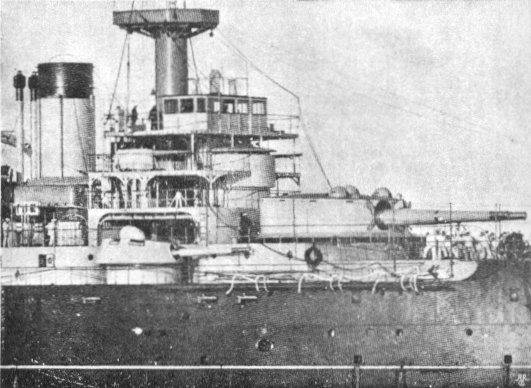
On the battleship Suffren, CT detail
The secondary armament comprised sixteen 45-caliber 164-millimeter (6.5 in) Modèle 1893–1896M guns. Twelve were in weather deck twin-gun turrets, six on each broadside. The remaining four guns were in hull casemates, two forward, two amidship. They were tall enough to not be disturbed much by seawater spray in heavy atlantic weather. They fired a 45–54.9-kilogram (99–121 lb) HE shell at 900 meters per second (3,000 ft/s) and at three rounds per minute. At maximum elevation of 15 degrees like the main guns, the casemate guns reached 9,000 meters (9,800 yd) wheeras the turret mounts enabled a better elevation for 10,800 meters (11,800 yd). 200 rounds were provided for each gun, including a few ready rounds in the turret.
Light Guns
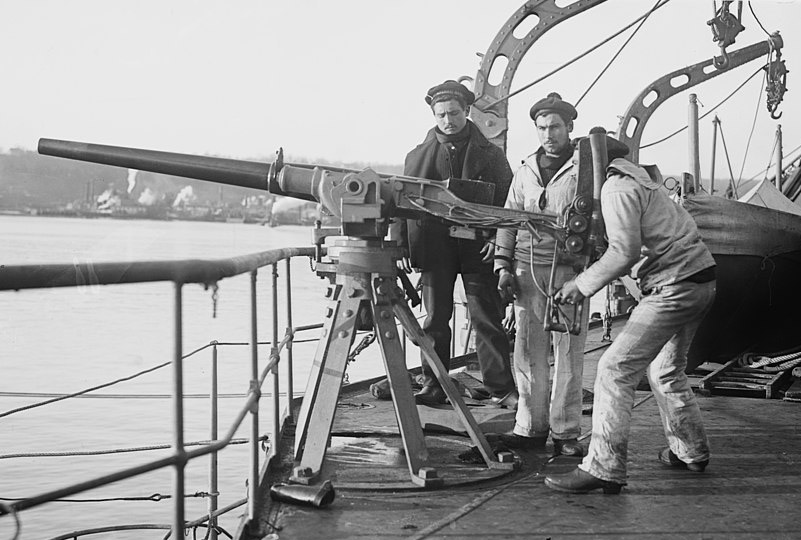
Hotchkiss 47 mm (3 pdr) revolver cannons
For torpedo boats close defence they also carried no les than twenty-four 47-millimeter (1.9 in) Hotchkiss guns. Victor Hugo differed by having these replaced by the more recent Canon de 47 mm modèle 1902 also from Hotchkiss instead. The latter fire a 2 kg (4.4 lb) unitary round at a muzzle velocity of 690 m/s (2,300 ft/s). These guns were installed on the weather deck, and on the structures for an aft, on two levels, some on the wings.
Mines and Torpedoes
The three cruisers also had as usual two above-water 450 mm (17.7 in) torpedo tubes mounted on broadsides.
Léon Gambetta unlike her sisters all had the same five 450-millimeter (17.7 in) torpedo tubes. Two were submerged on the broadside, below the waterline belt, and the remainder three was above water, broadside too, the on as a chase torpedo in the stern. A total of sixteen torpedoes were provided. The two others had no above-water tubes and just six torpedoes.
The first two ships had facilities to carry and handle ten naval mines, but Victor Hugo could handle twenty mines.

⚙ specs. as built |
|
| Displacement | 12,550 t (12,352 long tons) |
| Dimensions | 148.35* x 21.4 x 8.18m (486 ft 9 in* x 70 ft 3 in x 26 ft 10 in) |
| Propulsion | 3 shafts VTE engines, 20-28 WT boilers 27,500 PS (20,226 kW) |
| Speed | 22 knots (41 km/h; 25 mph) |
| Range | 7,500 nmi (13,900 km; 8,600 mi) at 10 knots (19 km/h; 12 mph) |
| Armament | 2×2 194 mm, 6×2, 4× 164 mm, 24× 47 mm Hotchkiss, 2-5× 450 mm TTs, 10-20 mines |
| Protection | Belt 80–150, Deck 33–65, Turrets 138 mm, sec. 102, casemates 102, CT 174 mm |
| Crew | 734; 779 as a flagship |
*Victor Hugo 149.07 m (489 ft 1 in)
 Léon Gambetta
Léon Gambetta
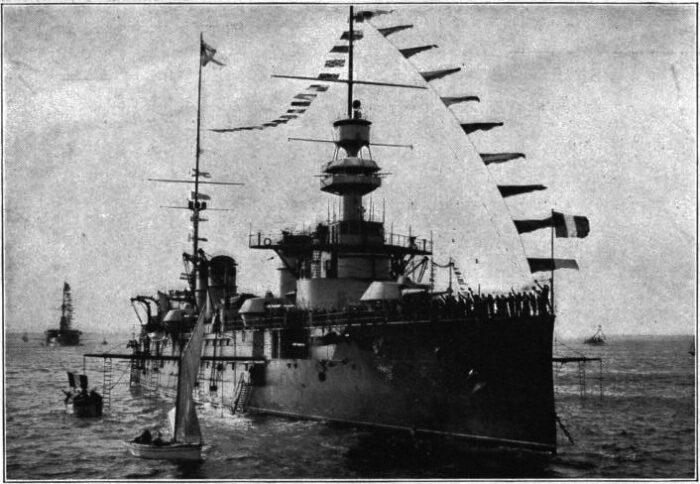
Navy Minister Jean Marie Antoine de Lanessan ordered Arsenal de Brest to start work on the lead ship, named after the former French Prime Minister on 2 July 1900 after the Naval Law which planned the first vessel FY1901. She was thus laid down on 15 January 1901, launched on 26 October 1902, with sea trials on 1 December 1903. She ran aground on uncharted rocks in fog by late February 1904 had her propellers and some hull plating replaced. Trials thus ended in August, and she ran aground again while negociated the narrow entrance to the River Penfeld in September having her bilge keels damaged and bent propellers blade. Official sea trials started by April 1905, she was commissioned on 21 July for a total budget of 29,248,500 francs.
She was assigned to the Northern Squadron as flagship of the 1st Cruiser Squadron under Vice Admiral Camille Gigon. She visited Portsmouth in August to commemorate the Entente Cordiale. Vice Admiral Horace Jauréguiberry heade the squadron from October she she was chosen to carry president Émile Loubet to Lisbon, Portugal. In May 1908 she transported Pdt. Armand Fallières to Dover and later in July she was present for the Quebec Tercentenary.
On 5 October 1909 she was now in the Northern 2nd Squadron. In January 1910 she was sent to the Mediterranean’s 1st DL, 1st Squadron later redesignated the 2nd DL and she became flagship in October. By 4 April 1911, she served with both her sisters under Rear Admiral Louis Dartige du Fournet, redesignated the 1st DL by 4 September. She took part in a fleet review for Pdt. Fallières off Toulon. Her unit became 2nd Sqn. again on 10 February 1912 still she was its divisional flagship.
From 3 August 1914, she hosted Rear Admiral Victor-Baptistin Senès when escorting troop convoys from Algiers to France. On 13 August Vice Admiral Augustin Boué de Lapeyrère directed all squadrons to the Adriatic. The armored cruisers followed the Albanian coast and RDV to Antivari on the 16th. SMS Zenta was caught and sank in the Battle of Antivari.
On 31 September four armored cruisers escorted SS Liamone while the French battleships shelled Cattaro. The 2nd DL escorted SS Henri Fraissinet to Antivari on 18–19 September and on the return trip, shelled Cattaro in the fog, until batteries fire was more precise. On 17 October there was a new uneventful sortie. Late October, the 2nd DL raided Lastovo island on 2 November. Jules Ferry was narrowly missed by the Austrian U-Boat U-5 on the 3th. The Jean Bart was torpedoed on 21 December and these sorties of large ships ended. Supply ships were escorted by armored cruisers still but the patrol line wa smoved further south, near Corfu.
On 10 January 1915 Boué de Lapeyrère was informed of a sortie of the Austro-Hungarian battlefleet and ordered Léon Gambetta, Ernest Renan, Waldeck-Rousseau and Jules Michelet to Corfu but this was a false alarm. On 24 January Léon Gambetta transported Montenegrin Foreign Minister to Medua in Albania, with also clothing and shoes for the Montenegrin Army but had a hard time unloading cargo. U-5 spotted her off Paxos could could not attack. Léon Gambetta escorted SS Whitehead to Medua on 5 April.
A German postcard with an artist’s depiction of the sinking of Léon Gambetta
Italy on 26 April agreed to declare war on Austria-Hungary and Boué de Lapeyrère moved his armored cruisers closer to the Strait of Otranto. Léon Gambetta meanwhile had been shadowed by Korvettenkapitän Georg Ritter von Trapp (U-5) and attacked at 00:40 on 27 April, 15 nm(28 km; 17 mi) south of Santa Maria di Leucia, Ionian Sea.
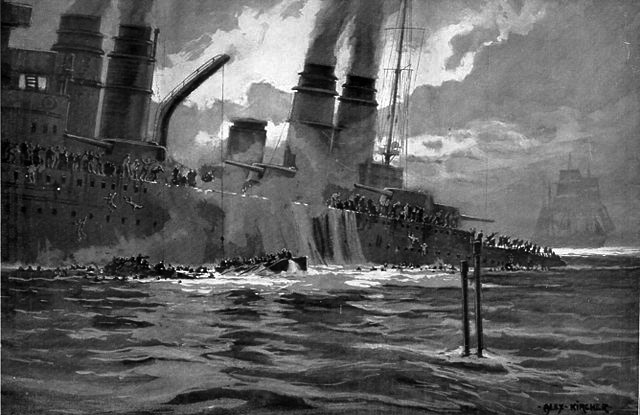
Von Trapp fired two from 500 meters (550 yd), which hit. One close to the dynamo room, the other the forward boiler room, the only ones operating. She lost all power and took a 15° list. Pumps had no energy and lifeboats could not be lwered, only by frantic effort, two were after 10 minutes, just before she capsized and sank. One lifeboat sank from overcrowding, 137 men survived our of 821, rescued by the Italian destroyers Impavido and Indomito and two torpedo boats. Squadron Admiral Senès and all his staff went down with her. This forced Adm. Boué de Lapeyrère to withdraw all his armored cruisers further south from the Gerogombos lighthouse (Cephalonia) at min. 14 knots (26 km/h; 16 mph) not 6 knots by Léon Gambetta to augment the patrol duration but make her a sitting duck as most her boilers were cold.
 Jules Ferry
Jules Ferry
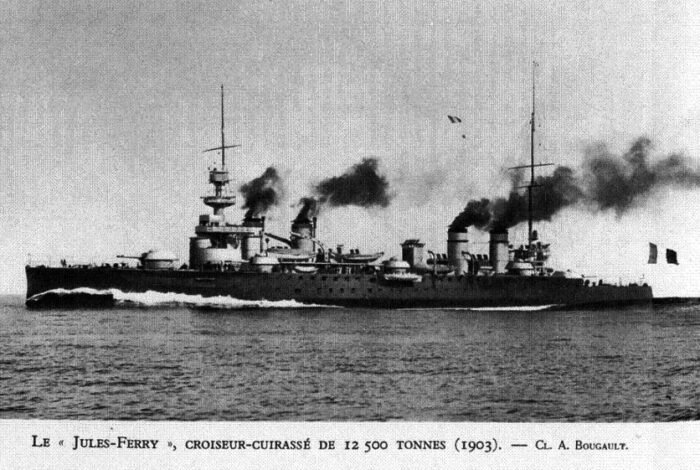
Named aftera former PM of France, she was also ordered by de Lanessan on 28 June 1900 to Arsenal de Cherbourg FY1901, laid down on 19 August, launched on 23 August 1903 and on sea trials on 23 June 1905. After many fixes, her full-power steam trials started in December 1906. She was commissioned on 1 June 1907 with total cost of 28,897,875 francs.
She was assigned to the Light Squadron, Mediterranean fleet as flagship, Vice Admiral JF. Joseph Krantz until mid-1909, then Vice Admiral Louis-Joseph Pivet. On 5 October 1909 in the Mediterranean Squadron she became the head of the 1st Squadron, replaced by Léon Gambetta on 4 April 1911 as she was transferred and the unit became the 2nd Squadron. She took part in the fleet for Armand Fallière. After the Agadir Crisis of 1911 and agreement was made of areas iof responsibilities in cases of war after the entente cordiale. France reconcentrated her fleet to the Mediterranean. The Med fleet became the 1st Naval Army with two light div. and Ferry and sisters in the 1st Light Squadron.
On 3 August 1914 she was in the 2nd DL, escorting troop convoys. Next she was sent to the Adriatic (see above). She was present in the action of Antivari, and escort missions of cargo ships to Antivari, like SS Liamone, SS Henri Fraissinet and shelling of Cattaro, island of Lastovo. Jules Ferry was narrowly missed by U-5 on the return voyage and she towed the submarine Curie to Pelagosa on 16 December for a planned attack on Pola. The loss of Jean Bart led to a reorganization with the cruiser relocated to Corfu.
Italy engaged with the entente from 26 April 1915, and the cruisers were moved to Strait of Otranto. Léon Gambetta was torpedoed and sunk by U- on the 27th and her sisters were moved further south in Cephalonia, paotrolling at 14 knots. With the effective entry of Italy on 23 May, they withdrew further in the Ionian Sea. The 2nd DL was sent alternatively to Alexandria and Bizerte or Malta and patrolled between Capo Colonna (southern Italy) and east of Crete.
By late 1915 it was decided to evacuated the Serbs in Montenegro and Albania and troops occupied Corfu as a resting place for the army. Jules Ferry ferried the occupation force on 11 January 1916. In March 1916, Argostoli wa scaptured as a base for the battlefleet, the armored cruisers being based north of Corfu. The Royal Serbian Army was evacuated with the cruisers in distant cover until 15 June. Shortages of coal and manpower degraded the situation and on 12 August 1917, the 2nd DL was disbanded. Jules Ferry became a transport while her sister Victor Hugo ended in reserve.
Jules Ferry wasn later sent in reserve in Bizerte in July 1918, reactivated in 1921 for Atlantic Flying Division and in 1923, Far Eastern Division. On 27 September 1923 she departed and arrived in Saigon (French Indochina) on 21 November. She was back at Toulon on 10 November 1925, in reserve, stricken on 19 January 1927 and sold for BU in 1928.
 Victor Hugo
Victor Hugo
Named after the French novelist and politician, she was ordered by De Lanessan to Toulon on 11 March 1901 but this order was transferred to the Arsenal de Lorient on 3 June 1902 as the Med Yard was budy completing two Gloire-class armored cruisers. All the assembled materials were transferred to Lorient, so she was only laid down on 2 March 1903 and many changed were made in her design. She was launched on 30 March 1904, starting sea trials only by 15 January 1907, commissioned on 16 April for a construction cost of 30,748,300 francs.
On 8 May she took part in the Jamestown Exposition with Kléber and Chasseloup-Laubat. By 20 May she was in New York City and back to Jamestown on 31 May for a naval review for president Theodore Roosevelt on 10 June. Back to France she was assigned to the Light Squadron, Mediterranean fleet. On 5 October 1909 her unit became the 1st Light Division (1st DL) and then 2nd DL, 1st Squadron by 4 April 1911, placed in reserve, reactivated by 10 February 1912. She was part later of the 1st Naval Army, 1st Light Squadron.
She escorted troopships from August 1914, then started operations in the Adriatic, same sorties as her sisters.
By late 1915, she took part in the Franco-British evacuation of the Serbian Army from Montenegro and Albania and occupation of Corfu and Argostoli. Shortages of coal and manpower hit her in 1917 but she still took part in the intervention against neutral Greek with Jules Michelet, patrolling the Gulf of Corinth to prevent Greek troops to move to the Peloponnese across the Corinth Canal and interfere with Allied operations in Athens. The 2nd DL landed a company of Senegalese troops on 11 June backed with a landing party of sailors armed with machine-guns, until King Constantine I abdicated. Greece then swifted to the allied side. On 12 August, the 2nd DL was disbanded. Victor Hugo was sent in to reserve to Bizerte.
On 18 December 1918 she was in Corfu as the hospital ship Flandre collided with her. She was damaged and sent to Toulon for repairs but replaced in reserve, and reactivated in 1921, reassigned to the Atlantic Flying Division like her sister Jules Ferry. She also was sent to the Far Eastern Divisio with Jules Michelet in Saigon from 19 April 1923 to 11 July and placed in reserve, stricken on 20 January 1928, sold for scrap on 26 November 1930.
Read More/Src
Books
Chesneau, Roger & Kolesnik, Eugene M., eds. (1979). Conway’s All the World’s Fighting Ships 1860–1905.
Dai, Wei (September 2020). “A Discussion on French Armored Cruiser Identification: From the Gueydon Class to the Edgar Quinet Class”. Warship International.
Freivogel, Zvonimir (2019). The Great War in the Adriatic Sea 1914–1918. Zagreb: Despot Infinitus.
Friedman, Norman (2011). Naval Weapons of World War One: Guns, Torpedoes, Mines and ASW Weapons of All Nations: An Illustrated Directory. Seaforth.
Halpern, Paul G. (2004). The Battle of the Otranto Straits: Controlling the Gateway to the Adriatic in World War I. Indiana University Press.
Jordan, John & Caresse, Philippe (2019). French Armoured Cruisers 1887–1932. Barnsley, UK: Seaforth Publishing.
Ropp, Theodore (1987). Roberts, Stephen S. (ed.). The Development of a Modern Navy: French Naval Policy, 1871–1904. NIP
Silverstone, Paul H. (1984). Directory of the World’s Capital Ships. New York: Hippocrene Books.0.
Friedman, Norman (2011). Naval Weapons of World War One. Seaforth.
Links
https://en.wikipedia.org/wiki/L%C3%A9on_Gambetta-class_cruiser
http://www.navypedia.org/ships/france/fr_cr_leon_gambetta.htm
https://commons.wikimedia.org/wiki/Category:L%C3%A9on_Gambetta_class_armoured_cruisers
full plans on 3dhistory.de
Model Kits
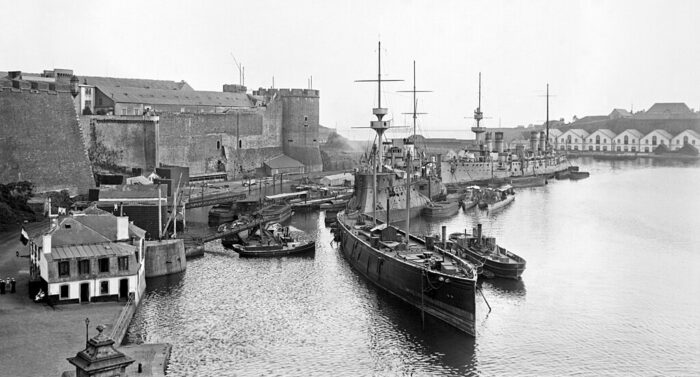
Agence Rol, Brest fortress and berth, Inflexible and Victor Hugo

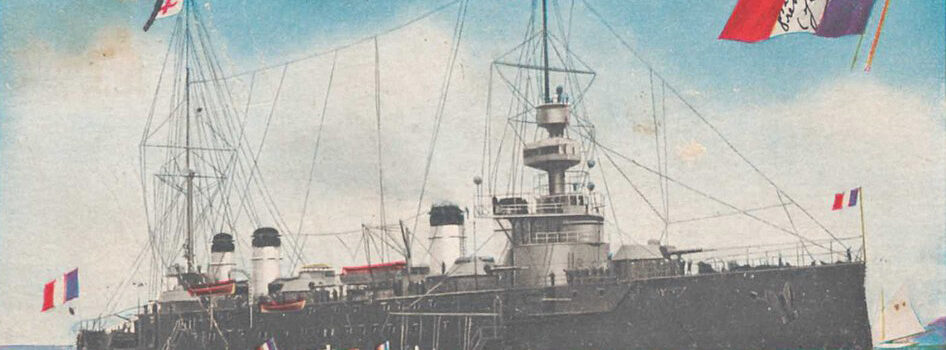

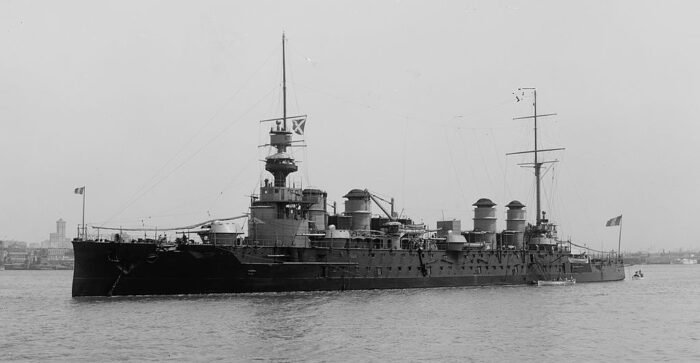
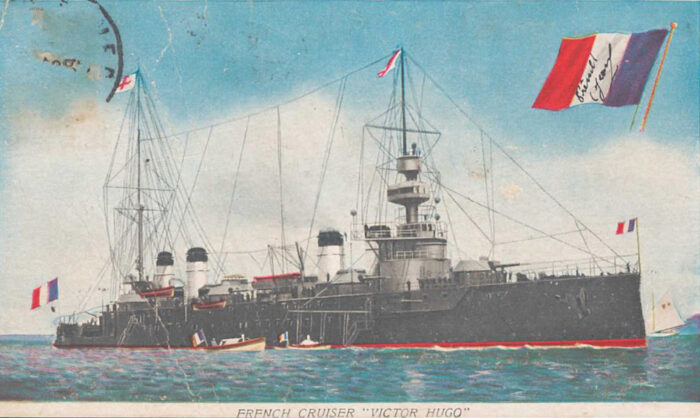
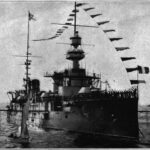
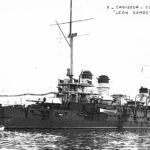
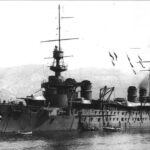
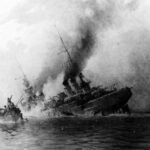
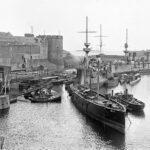
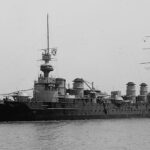
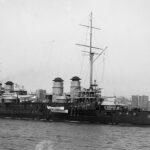
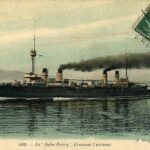
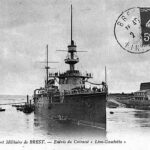
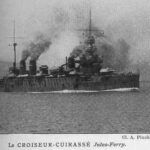
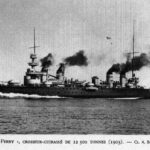

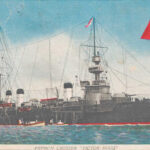
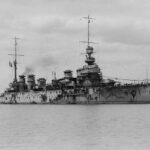
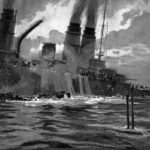
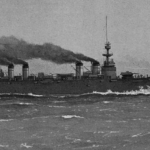
 Latest Facebook Entry -
Latest Facebook Entry -  X(Tweeter) Naval Encyclopedia's deck archive
X(Tweeter) Naval Encyclopedia's deck archive Instagram (@navalencyc)
Instagram (@navalencyc)





 French Navy
French Navy Royal Navy
Royal Navy Russian Navy
Russian Navy Armada Espanola
Armada Espanola Austrian Navy
Austrian Navy K.u.K. Kriegsmarine
K.u.K. Kriegsmarine Dansk Marine
Dansk Marine Nautiko Hellenon
Nautiko Hellenon Koninklije Marine 1870
Koninklije Marine 1870 Marinha do Brasil
Marinha do Brasil Osmanlı Donanması
Osmanlı Donanması Marina Do Peru
Marina Do Peru Marinha do Portugal
Marinha do Portugal Regia Marina 1870
Regia Marina 1870 Nihhon Kaigun 1870
Nihhon Kaigun 1870 Preußische Marine 1870
Preußische Marine 1870 Russkiy Flot 1870
Russkiy Flot 1870 Svenska marinen
Svenska marinen Søværnet
Søværnet Union Navy
Union Navy Confederate Navy
Confederate Navy Armada de Argentina
Armada de Argentina Imperial Chinese Navy
Imperial Chinese Navy Marinha do Portugal
Marinha do Portugal Mexico
Mexico Kaiserliche Marine
Kaiserliche Marine 1898 US Navy
1898 US Navy Sovietskiy Flot
Sovietskiy Flot Royal Canadian Navy
Royal Canadian Navy Royal Australian Navy
Royal Australian Navy RNZN Fleet
RNZN Fleet Chinese Navy 1937
Chinese Navy 1937 Kriegsmarine
Kriegsmarine Chilean Navy
Chilean Navy Danish Navy
Danish Navy Finnish Navy
Finnish Navy Hellenic Navy
Hellenic Navy Polish Navy
Polish Navy Romanian Navy
Romanian Navy Turkish Navy
Turkish Navy Royal Yugoslav Navy
Royal Yugoslav Navy Royal Thai Navy
Royal Thai Navy Minor Navies
Minor Navies Albania
Albania Austria
Austria Belgium
Belgium Columbia
Columbia Costa Rica
Costa Rica Cuba
Cuba Czechoslovakia
Czechoslovakia Dominican Republic
Dominican Republic Haiti
Haiti Hungary
Hungary Honduras
Honduras Estonia
Estonia Iceland
Iceland Eire
Eire Equador
Equador Iran
Iran Iraq
Iraq Latvia
Latvia Liberia
Liberia Lithuania
Lithuania Mandchukuo
Mandchukuo Morocco
Morocco Nicaragua
Nicaragua Persia
Persia San Salvador
San Salvador Sarawak
Sarawak Uruguay
Uruguay Venezuela
Venezuela Zanzibar
Zanzibar Warsaw Pact Navies
Warsaw Pact Navies Bulgaria
Bulgaria Hungary
Hungary

 Bundesmarine
Bundesmarine Dutch Navy
Dutch Navy Hellenic Navy
Hellenic Navy Marina Militare
Marina Militare Yugoslav Navy
Yugoslav Navy Chinese Navy
Chinese Navy Indian Navy
Indian Navy Indonesian Navy
Indonesian Navy JMSDF
JMSDF North Korean Navy
North Korean Navy Pakistani Navy
Pakistani Navy Philippines Navy
Philippines Navy ROKN
ROKN Rep. of Singapore Navy
Rep. of Singapore Navy Taiwanese Navy
Taiwanese Navy IDF Navy
IDF Navy Saudi Navy
Saudi Navy Royal New Zealand Navy
Royal New Zealand Navy Egyptian Navy
Egyptian Navy South African Navy
South African Navy






























 Ukrainian Navy
Ukrainian Navy dbodesign
dbodesign